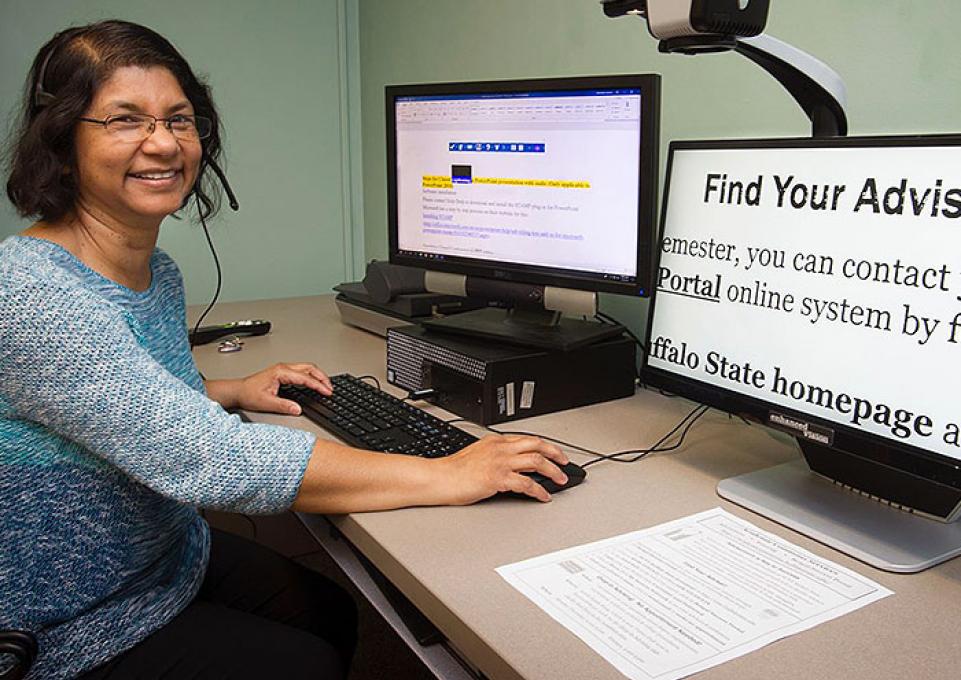
Back in March, a sled hockey team using the Sports Arena ice rink had trouble getting in and out of the visiting hockey locker rooms. They emailed their concerns with the facility to rink manager Jim Fowler, who then notified Steve Shaffer and Brian Wittmer from facilities.
Within hours, they checked out the locker room. While everything was up to code at the time the building was constructed and looked good, they noticed that the key hole for the lock was too high for the players. The campus locksmith was immediately called to fix the issue, Wittmer, the college’s design and construction manager, said.
“We take it seriously,” Wittmer said. “If there's a complaint, we have a team of people who can go and investigate.”
That’s just one example of the ways Buffalo State works every day to increase accessibility for students, staff, and visitors.
In terms of the physical layout of campus, changes really kicked into gear in the early 1990s, Wittmer said, with the passing of the Americans with Disabilities Act of 1990. At that time, the campus underwent an accessibility upgrade, over the course of multiple projects meant to increase access.
For example, Wittmer said, elevators were added where possible, in buildings like Chase and Cassety halls. They also looked at the way wheelchairs were able to gain entry into buildings, and improve those routes.
“Also, once they're in the building, we made sure that the drinking fountains were accessible, and the bathrooms, and classrooms,” he said.
The main accessibility goal in the 1990s and early-2000s was to make sure students could physically get around campus, regardless of mobility issues, Wittmer said. That also included making sure there were enough handicap parking spaces on campus.
Once the older buildings were put into compliance, the campus focused on new builds, and made sure they were in compliance from the start, Wittmer said.
“Once we got that done, anything going forward, automatically met the requirements,” he said.
While the 1990s and early-2000s focused on mobility issues, accessibility on campus has expanded to universal design for those with hearing and visual disabilities, learning disabilities, and working to make sure aging populations can access and use campus resources.
That’s where Student Accessibility Services comes in. The goal of the office, according to Lisa Morrison-Fronckowiak, the office’s director, is to ensure that all programs, classes, and activities on campus are accessible to students with disabilities.
“We're really trying to provide the tools that students with disabilities need in order to level the playing field,” she said. “We know that they're coming in with a disadvantage already.”
That could mean anything from providing testing accommodations to providing textbooks in different formats that are easier for the student to use, Morrison-Fronckowiak said.
“The reality is that the accommodations are determined on a case-by-case or course-by-course basis,” she said. “So it's really engaging in an interactive process with the student.”
For the most part, students self-identify with a disability, Morrison-Fronckowiak said. Sometimes, a faculty member will refer a student to the Student Accessibility Services Office, if they feel the student needs assistance.
“Most of our information comes from really just talking to the students, figuring out their strengths, their weaknesses, how they learned this, and then going from there,” she said. “And then how best can accommodate that.”
In order to help students who may have a disability, but haven’t self-identified, the campus has installed text-reading software on the computers around campus.
“It’s promoting universal design,” Morrison-Fronckowiak said. “People don't have to come and ask for something special, it's just already there for them. And that's something that we're really hoping to incorporate in more aspects of the campus and the curriculum—encouraging faculty to incorporate more aspects of universal design in their classroom.”
In a recent op-ed in the Buffalo News, “Another Voice: Colleges must empower students with learning disabilities,” President Katherine Conway-Turner said it’s the school’s mission to make higher education available for everyone, regardless of disability.
“At Buffalo State, we are proactive in identifying students with learning disabilities and offering them individualized attention and the tools they need to obtain a degree,” she wrote.
Finding ways to help students succeed is an ongoing process at Buffalo State, Conway-Turner said.
“Institutions of higher learning must continue to advance creative methods, refine technologies, and research new strategies that give all students the opportunity to succeed,” she wrote.
While Student Accessibility Services is currently located in Twin Rise, it will be moving to the Academic Commons in E. H. Butler Library when renovations are completed next year. That will give the office more room to provide services to students, Morrison-Fronckowiak said.
“We're hoping that because it's in the library, and is centrally located, it will encourage more students who may be there using the tutoring services to speak with somebody who realizes they may need to refer to our area as well,” she said. “And so we're really hoping that it encourages more students to take advantage of our services.”
